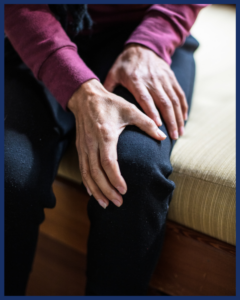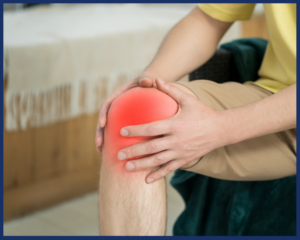Regenerate, Don’t Replace: Healing Your Joints Without Surgery
Introduction

If you’re in your 40s or 50s and living with nagging knee or hip pain, the thought of a major joint surgery may feel like a last resort. You might even have been told you’ll eventually need a joint replacement. But joint replacements don’t last a lifetime – and getting a second one (a revision) is no walk in the park. The good news is there’s another path: regenerative medicine offers a way to relieve pain and rebuild joint health from within, helping you avoid or delay surgery. In this blog, we’ll explore why traditional joint replacements have their limits, and how cutting-edge regenerative therapies like BMAC, A2M, PRP, and Wharton’s Jelly can rejuvenate your joints through a simple three-step injection process. We’ll break down the science in clear terms and highlight real-world benefits – all in an engaging, conversational tone that empowers you to make informed decisions about your joint health.
The Problem: Why Joint Replacements Aren’t a One-Time Fix
For decades, the go-to solution for severe knee or hip arthritis has been joint replacement surgery. It can indeed reduce pain – but it’s not a permanent fix. Most artificial joints have a limited lifespan of around 15–20 years. That means if you get a knee replacement at 50, there’s a good chance you’ll outlive your new joint and need another operation down the line. And here’s the kicker: revision surgeries are even more challenging. Surgeons and researchers note that a second joint replacement is technically more difficult, recovery often takes longer, and success rates are typically lower than the first time. In other words, replacing a replaced joint isn’t as effective as the original surgery.
Why don’t replacements last forever? Think of your artificial joint as having “mileage.” The metal and plastic parts slowly wear down with use. Younger or more active patients rack up mileage faster, so their implants wear out sooner. Many doctors actually advise people in their 40s and 50s to delay joint surgery as long as possible, because every extra year you can manage with your natural joint is a year you push off the clock on an artificial one. Plus, no surgery is without risk – infections, blood clots, or complications can happen. It’s no wonder adults in mid-life are looking for alternatives that can relieve pain and keep them active without immediate surgery.
Advanced osteoarthritis causes cartilage loss, bone spurs, and joint damage. Over time this can lead to chronic pain and may prompt consideration of joint replacement. Regenerative medicine offers a way to tackle this damage by helping the body heal the cartilage and calm inflammation, potentially avoiding the need for artificial joint parts.
A New Hope: How Regenerative Medicine Can Save Your Joints
Imagine if your body could heal your painful joint from the inside – repairing damage rather than replacing the whole joint. That’s the promise of regenerative medicine. Instead of installing metal and plastic, regenerative therapies use your body’s own cells and healing proteins (or those derived from natural sources) to repair and renew injured tissues. These treatments are typically delivered through injections – meaning no major incisions, no hospital stays, and far less downtime than surgery.
Let’s introduce the key players in this regenerative approach:
- BMAC (Bone Marrow Aspirate Concentrate): A concentrate of cells taken from your own bone marrow (usually from the back of your hip). BMAC is rich in mesenchymal stem cells and other healing cells. Stem cells are like the body’s repairmen – they can turn into cartilage or bone cells and release signals that spur healing. BMAC also contains platelets and growth factors, making it a powerful healing cocktail. By drawing a small sample of your marrow, concentrating it, and injecting it into your bad joint, doctors deliver a high dose of your body’s natural repair cells exactly where they’re needed.
- PRP (Platelet-Rich Plasma): A component derived from your blood. Platelets are famous for clotting cuts, but they also carry a payload of growth factors that kickstart tissue repair. In fact, platelets are the “first responders” when you get injured – they release signals that recruit other cells and control inflammation. To create PRP, a small tube of your blood is spun in a centrifuge to concentrate the platelets into a small volume of plasma. When injected into an arthritic or injured joint, PRP floods the area with growth factors, reducing inflammation and calling in the body’s healing forces. It’s like sending a repair crew to a damaged site with all the tools they need.
- A2M (Alpha-2-Macroglobulin): A special protein found in your bloodstream that acts like a molecular sponge for bad enzymes. In arthritic joints, there are destructive enzymes (such as MMPs and inflammatory cytokines) that chew up cartilage and cause inflammation. A2M can bind to those enzymes and neutralize them. By concentrating A2M from your blood and injecting it into a painful joint, we essentially knock out the “cartilage eaters.” Think of A2M as a Pac-Man gobbling up the chemicals that cause wear-and-tear in your joint. This protects your cartilage from further breakdown and helps reduce pain and swelling. Early research even suggests A2M injections may slow the progression of arthritis by halting cartilage damage.
- Wharton’s Jelly Cellular Therapy: This therapy uses cells derived from Wharton’s Jelly, a gelatinous substance in umbilical cord tissue. Wharton’s Jelly is an ethically sourced material (usually from donated birth tissues) that is packed with young, potent mesenchymal stem cells and growth factors. Unlike your adult cells, these perinatal cells are very robust and youthful. Laboratory studies and early clinical trials have found Wharton’s Jelly stem cells to be a safe and promising option for osteoarthritis, showing an “encouraging alternative” to manage knee arthritis. They may help reduce pain and even aid cartilage regeneration in the joint. In practical terms, Wharton’s Jelly injections give a boost of ready-to-go regenerative cells without the need to harvest your own marrow. (Important note: while results are promising, this therapy is still under study to fully confirm its long-term effectiveness.)
Each of these therapies tackles joint damage in a different way – from neutralizing harmful chemicals (A2M) to delivering building blocks for new tissue (BMAC/Wharton’s) to igniting the healing process (PRP). What if we combine their strengths? That’s where the comprehensive three-step injection process comes in.
The Three-Step Injection Process: Renewing Your Joint from Within
Treating an arthritic joint with regenerative medicine isn’t a one-and-done event – it’s more like a healing program. In many clinics, doctors use a series of three injections, spaced over several weeks, to methodically reduce pain and jumpstart regeneration. Here’s how a typical three-step process works:
Step 1: Kick out the “Bad Guys” (Week 0)
The first injection often involves A2M (Alpha-2-Macroglobulin). The goal here is to prepare the joint environment for healing by removing the destructive elements. Think of an old garden: before you plant new seeds, you pull out the weeds. A2M is injected into the joint to act as a molecular weed-killer – it binds up those cartilage-destroying enzymes and inflammatory cytokines. Patients might not feel dramatic improvement immediately, but this step is quietly doing important work: protecting your remaining cartilage and reducing ongoing inflammation. By trapping the “bad guys” early, we create a healthier foundation for the next steps. (This injection is usually well-tolerated; it’s similar to a standard joint injection and you might have mild soreness for a day or two.)
Step 2: Plant the Seeds of Healing (Week 2)
With the joint cleansed of some inflammatory villains, it’s time to add the healing agents. In step two, you receive an injection of regenerative cells – either your own BMAC (bone marrow concentrate) or donated Wharton’s Jelly, or sometimes a combination. This is the heavy-hitter step where we introduce stem cells and growth factors directly into the joint. These cells are like planting seeds in that prepared garden soil. Once injected, the stem cells can detect the areas of damage and begin orchestrating repair. They can transform into new cartilage cells or release signals that encourage your existing cells to repair tissue. Additionally, the presence of these cells has a strong anti-inflammatory effect – they literally calm down overactive immune responses in the joint. Many patients don’t notice big changes immediately after the injection (aside from possibly some achy fullness in the joint for a few days), but beneath the surface, the repair crew is getting to work. Over the next few weeks, these cells will help regrow collagen, reduce inflammation, and even form new cartilage matrix in areas where it’s been worn away. It’s a gradual construction project inside your knee or hip.
Step 3: Nourish and Support (Week 4-6)
The final injection in the series typically uses PRP (Platelet-Rich Plasma), drawn from your blood. Why do this after the stem cells? Because PRP is like the fertilizer and water for those newly planted seeds. The platelets in PRP release a cascade of growth factors that nourish the stem cells and help them thrive, as well as further reducing any lingering inflammation. This third injection essentially boosts the regenerative process to maximize the outcome. Patients sometimes report this PRP injection feels a bit more sore than the others for a day or two – that’s normal, as PRP can cause a brief inflammatory response (a sign that the healing process is being stimulated). After that, it’s mostly a matter of being a little patient and letting your body do what it does best: heal.
What to expect during this process
These injections are outpatient procedures – done in a clinic setting, often with ultrasound guidance to pinpoint the exact spot. Each injection visit might take about an hour or less (most of that time is preparing the injectate – drawing blood or marrow and processing it). The injections themselves are done with local numbing; discomfort is usually minimal, similar to a steroid shot you might have had in the past. There’s no large incision, no general anesthesia, and you walk out on the same day. Typically, you’ll be advised to take it easy on high-impact activities for a short period, but unlike major surgery, the downtime is very short. Some patients even continue working (with minor activity modifications) through the treatment series.
What to expect in results
Regeneration is not an overnight miracle – it’s a gradual improvement. Many people start noticing decreased pain and stiffness within a few weeks after the final injection, with significant improvements often appearing around the 4-8 week mark. Studies and clinical experience have shown that by harnessing your body’s healing, these treatments can lead to meaningful pain reduction and better joint function for a large portion of patients. One Mayo Clinic specialist noted that 40–70% of patients who undergo PRP/BMAC injections for arthritis get noticeable pain relief, allowing them to return to activities they love. In other words, while no treatment works for everyone, the odds are quite good that regenerative therapy can help you feel better and move easier without surgery. Improvements tend to continue over time – many patients report even more mobility and less pain at 3 months, 6 months, and beyond as the healing progresses. And the best part? You’ve addressed the cause (worn-out tissue and inflammation) rather than just masking the pain.
The Science (Made Simple): Why These Injections Work
You might be wondering, “Does this really regrow cartilage? What’s actually happening in my knee?” Let’s break down the biology in everyday terms. In an arthritic joint, the problem is a bit like a pothole-ridden road with ongoing traffic:
- Over the years, cartilage (the smooth cushioning) wears thin – think of this as the road surface getting potholes. You feel pain because bone is rubbing on bone in spots and because nerves sense the damage.
- The joint also fills with inflammatory chemicals and enzymes – like construction trucks gone rogue, actually making the potholes worse by chipping away at the road (these are the MMPs and inflammatory molecules that A2M targets).
- Traditional treatments (pain meds, steroid shots) are like pouring some sand in the potholes or putting up a “bump” sign – they might temporarily lessen the jolt, but they don’t fix the road.
Regenerative medicine aims to fix the road and calm the traffic:
- Alpha-2-Macroglobulin (A2M) is the traffic controller and cleanup crew. It removes the destructive enzymes (the rogue trucks) that are breaking down cartilage. With fewer “bad actors” in the joint, your natural tissue isn’t under constant attack. This creates a healthier environment where healing can take place, and inflammation subsides (meaning less pain).
- Stem Cells (from BMAC or Wharton’s Jelly) are the master repairmen. They go to the sites of cartilage damage and can directly fill in as new cartilage cells or encourage nearby cells to do so. They secrete anti-inflammatory substances as well, further reducing pain and swelling in the joint. Picture tiny construction workers patching up the potholes with fresh pavement. Over time, these patches integrate and improve the smoothness of your joint’s motion. Wharton’s Jelly cells, being very youthful, are especially energetic repairmen – although current evidence suggests both your own marrow cells and donated Wharton’s Jelly can contribute to healing.
- Platelets (PRP) are the foremen and growth boosters. When platelets arrive, they release a flurry of growth signals – sort of like an instruction manual plus a boost of fuel for repair. They tell stem cells what to do and call in blood flow to nourish the area. In our road analogy, PRP is like securing funding and materials for the construction crew and making sure the work zone is well-supplied. PRP by itself has been shown to help arthritis – for example, clinical studies show PRP injections can reduce pain and improve knee function for many patients over 6 months or more. When used alongside A2M and stem cells, PRP helps ensure those therapies have the best chance to succeed.
The beauty of this approach is that it’s working with your body’s natural healing system instead of against it. We’re essentially giving Mother Nature a helping hand – concentrating and delivering the elements she uses to repair tissues. This means the healing is holistic – rebuilding tissue, not just numbing pain. Patients often find that not only is pain reduced, but joint stability and mobility improve because the supporting tissues (ligaments, tendons, cartilage) are stronger and healthier after treatment. And unlike cortisone shots (which can actually degrade cartilage with overuse), regenerative injections are aimed at long-term joint health. Of course, every individual’s biology is different, and results can vary. Some people may experience dramatic improvement, while others get more modest benefits. The goal is to tilt the odds in your favor to heal instead of deteriorate.
Crucially, we avoid any overblown claims here: can we guarantee you’ll never need a knee replacement? No – and you should be wary of anyone who does promise a “miracle cure.” What this therapy offers is a chance to significantly improve your symptoms and function without surgery, and potentially delay or even avoid the need for an artificial joint. The science behind it – from the cellular biology to clinical trial results – backs up that it can help many people regain a better quality of life.
Real-World Benefits: Pain Relief, Mobility, and Long-Term Joint Health
• Significant Pain Reduction
By targeting the inflammation and damage at its source, regenerative injections can lead to noticeable pain relief. Many patients report their daily aches subsiding to a dull whisper or even disappearing, allowing them to cut back on pain medications. In studies, a majority of arthritis patients saw pain scores drop after PRP or stem cell treatments. Importantly, this relief tends to last months or years, not just weeks. Unlike a steroid shot that might wear off in a couple of months, successful regenerative therapy can have long-lasting effects since it’s helping to actually repair tissue. (Some patients may choose to do a “booster” PRP shot a year or two later to maintain the benefits, but others don’t need to.)
• Better Mobility and Function
Reduced pain is wonderful, but the true victory is getting your life back. Patients often find they can walk farther, climb stairs more easily, and get back to activities they love – be it gardening, cycling, or playing with the grandkids. With healthier cartilage and less inflammation, your joint simply moves better. Think of it as less creaky and more fluid. Clinical experts emphasize that the primary goal is to improve symptoms enough to allow patients to do the things they want to do. Whether that’s training for a 5K or just walking the dog without limping, regenerative medicine can be a gateway to restored freedom of movement.
• Minimally Invasive with Quick Recovery
Compared to surgery, the convenience is hard to overstate. You’re not going under the knife, not accumulating a pile of hospital bills, and not facing months of rehab to learn to use a new joint. After an injection series, most people gradually resume their normal exercise and routines within days, and ramp up to higher-impact activities over several weeks. There’s usually no need for crutches or extensive physical therapy (though targeted exercises or therapy can certainly enhance results, and many clinics will guide you on gentle rehab to strengthen muscles around the joint). Essentially, you’re healing while living your life, instead of putting your life on pause to recover from an operation.
• Long-Term Joint Health (Delay or Avoid Surgery)
Perhaps the biggest benefit, in the long view, is that you are preserving your natural joint. Every year that you maintain your own knee or hip is a year you avoid the risks and limitations of an artificial one. By investing in regenerative treatment, you’re hoping to buy yourself many more years of comfortable movement before a replacement is ever on the table – or possibly avoid it altogether. There are patients now a few years out from their injections who remain pain-free and active, effectively putting the prospect of joint replacement on the back burner indefinitely. Even if you eventually do need surgery, you’ve delayed it to an older age when that 15-20 year implant lifespan is less likely to be an issue. And who knows – future advances might extend implant longevity or offer new options by then. In short, regenerative medicine keeps options open and your natural tissues as healthy as possible. It’s about changing the trajectory of arthritis from a downward spiral into a stabilized or improving condition.
A quick reality check:
Regenerative treatments are not a silver bullet. Not everyone achieves a home-run result, and severe arthritis (where the joint is very far gone) might not respond as robustly as early-to-moderate damage. But even in difficult cases, patients often gain enough relief to postpone surgery and improve quality of life. The absence of major side effects means the potential upside outweighs the risks for most. When you compare a series of injections (with low complication rates) to a major surgery (with considerable risks and rehab), it makes sense to consider the injections first in many scenarios. As one orthopedic expert put it, regenerative therapy is acceptably safe and can harness the body’s healing with a pretty good success rate – it may or may not reduce your pain, but if it does, it can be life-changing.
Moving Forward: Is Regenerative Medicine Right for You?
By now, you’ve learned how and why regenerative medicine can bolster joint health and relieve pain, especially for folks in mid-life looking to avoid that first (or second) joint replacement. You might be thinking, “This sounds promising – what’s my next step?” Here are a few suggestions:
• Do Your Research & Ask Questions
Look for orthopedic or sports medicine physicians who specialize in orthobiologics (the fancy term for these regenerative treatments). Ask if they have experience with BMAC, PRP, A2M, or Wharton’s Jelly for joints. Inquire about results they’ve seen in patients like you, and any preparatory or follow-up rehab protocols they recommend. A reputable provider will be honest about what’s known and not yet known, and won’t pressure you with guarantees.
• Evaluate Your Candidacy
Not every patient is an ideal candidate for regenerative therapy, so have a frank discussion about your specific condition. Factors like the severity of arthritis, your overall health, and even lifestyle (e.g. smoking can impede healing) can influence the outcome. A good clinic will usually review your X-rays or MRI and give you a realistic idea of how much improvement to expect. They may also suggest complementary steps like weight management or physical therapy exercises to maximize your joint’s ability to heal.
• Consider the Investment
These treatments, especially cell therapies, can be an investment (and not always covered by insurance yet). However, when weighing that cost, consider the value of avoiding a $50,000 surgery and months off work, or the priceless value of being pain-free. Many patients find it well worth it, but it’s a personal decision. Some start with the more accessible PRP (often less costly) to see how they respond, then add BMAC or others if needed.
• Be Patient and Stay Positive
If you opt for regenerative injections, go in with an optimistic yet patient mindset. You won’t be “fixed” overnight – but you will likely start noticing small improvements week by week. Keep a journal of your pain and activities; sometimes the change is so gradual you only realize later, “Hey, I walked an extra mile this week without stopping” or “I haven’t needed my cane in days.” Celebrate those milestones. And continue to take care of your joints with exercise, good nutrition (nutrients like omega-3s can help joints), and avoiding things that aggravate your pain.
In closing, regenerative medicine is changing the game for joint pain sufferers. It offers a gentler, biologically intelligent approach to healing that resonates with those of us who want to stay active and age gracefully – without unwarranted surgeries. The field is advancing rapidly, with new studies and techniques emerging each year, so it’s an exciting time to explore these options. If you’re tired of living with joint pain and wary of going under the knife, consider giving your body’s own healing power a chance. Consult with a regenerative medicine specialist to see if treatments like A2M, PRP, BMAC, or Wharton’s Jelly could be your ticket to moving freely again. Your 40s, 50s, and beyond can absolutely be active and pain-free years – sometimes all it takes is a little regeneration.
Remember: Always consult with a qualified healthcare provider before making decisions about your medical care. This blog is for educational purposes and is not a substitute for professional medical advice.



